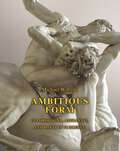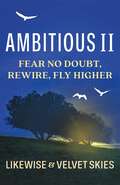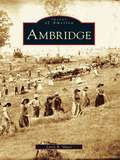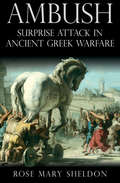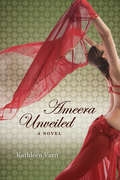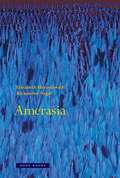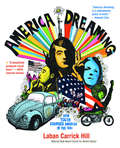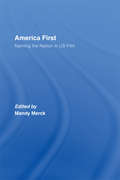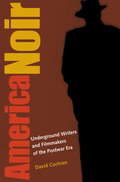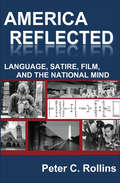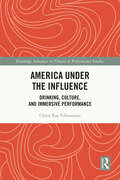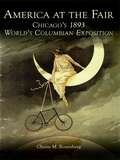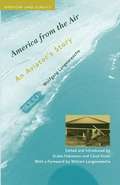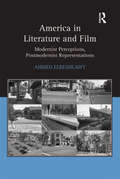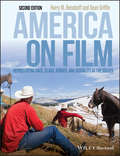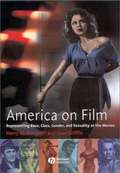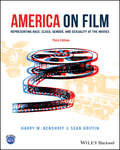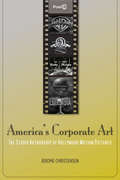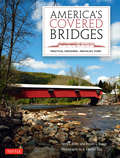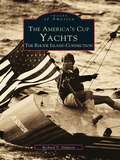- Table View
- List View
Ambition, Art, and Image-Making in an Early Quattrocento Court: The Palazzo Trinci Frescoes (Routledge Research in Art History)
by Sarah RobertsThis study provides new interpretations of the little-known but fascinating Palazzo Trinci frescoes, relating them for the first time both to their physical context and to their social, political, and cultural environment.Chapters show how a humanist agenda subverted the historical and mythical associations more frequently used to promote powerful families, to point the Trinci family in new directions. It also shows how the artists involved adapted established civic, religious, and chivalric imagery in support of these ideas. The book argues that the resulting decorations are highly unusual for the period, in their serious political and social purpose. Positioning the Trinci as bringers of peace, not war, the family is now associated with culture and education and presented as willing to encourage debate about the character of the virtuous ruler and the nature of good government.The book will be of interest to scholars working in art history and Renaissance studies.
Ambitious Form: Giambologna, Ammanati, and Danti in Florence
by Michael W. ColeAmbitious Form describes the transformation of Italian sculpture during the neglected half century between the death of Michelangelo and the rise of Bernini. The book follows the Florentine careers of three major sculptors--Giambologna, Bartolomeo Ammanati, and Vincenzo Danti--as they negotiated the politics of the Medici court and eyed one another's work, setting new aims for their art in the process. Only through a comparative look at Giambologna and his contemporaries, it argues, can we understand them individually--or understand the period in which they worked. Michael Cole shows how the concerns of central Italian artists changed during the last decades of the Cinquecento. Whereas their predecessors had focused on specific objects and on the particularities of materials, late sixteenth-century sculptors turned their attention to models and design. The iconic figure gave way to the pose, individualized characters to abstractions. Above all, the multiplicity of master crafts that had once divided sculptors into those who fashioned gold or bronze or stone yielded to a more unifying aspiration, as nearly every ambitious sculptor, whatever his training, strove to become an architect.
Ambitious II: Fear No Doubt, Rewire, Fly Higher
by LikewiseAMBITIOUS II is a motivating, eye-opening venture to explore the inhibiting areas of fear, anxiety, and doubt. You will relate right away. Written from Likewise's vantage point and interspersed with his pivotal episodes, his knowledge, groundbreaking methods, and sincere eagerness to assist the readers shine brilliantly throughout the pages. This timely book is choc-full of original concepts, terms, and tips. Find out how to transform from a "negative noggin" to a "positive processor." Discover your personality type: are you "smooth-wired," "lightning-wired," or a "smooth-lightning wired" dynamo? Ultimately, you will learn how to successfully rewire and fly higher!
Ambridge
by Larry R. SlaterIn 1905, the German religious settlement of Economy changed forever from what its charismatic founder had planned in 1824. Built to await the Second Coming, Economy was passed from the hands of the moribund Harmony Society to the American Bridge division of United States Steel Corporation. The new owners renamed the town Ambridge. As the mill town burst into life, the population spiked from 600 to approximately 37,000 by 1945. Inevitably, Ambridge felt the collapse of big steel. In the 1750s, this land along the Ohio River held Log Town, which was a meeting place for Colonial and Native American leaders. Later there was Legionville, where Gen. Anthony Wayne trained American troops during the early Indian wars. This was followed by the final home of a utopian society and one of the largest mill complexes of the 20th century. Through vintage photographs, Ambridge chronicles the diverse history and evolution of this community.
Ambush: Surprise Attack in Ancient Greek Warfare
by Rose Mary SheldonThere are two images of warfare that dominate Greek history. The better known is that of Achilles, the Homeric hero skilled in face-to-face combat to the death. He is a warrior who is outraged by deception on the battlefield. The alternative model, equally Greek and also taken from Homeric epic, is Odysseus, the man of twists and turns of The Odyssey. To him, winning by stealth, surprise or deceit was acceptable.Greek warfare actually consists of many varieties of fighting. It is common for popular writers to assume that the hoplite phalanx was the only mode of warfare used by the Greeks. The fact is, however, that the use of spies, intelligence gathering, ambush, and surprise attacks at dawn or at night were also a part of Greek warfare, and while not the supreme method of defeating an enemy, such tactics always found their place in warfare when the opportunity or the correct terrain or opportunity presented itself.Ambush will dispel both the modern and ancient prejudices against irregular warfare and provides a fresh look at the tactics of the ancient Greeks.
Ameera, Unveiled
by Kathleen VarnAt the age of forty-eight, happily remarried and retired from her legal assistant, gerbil wheel, Kat decides to break out of her shell and try her hand at belly dancing. What begins as a hobby leads her to filling a coveted spot in Palmetto Oasis Middle Eastern Dance Troupe. With less than eight weeks to prepare, Kat's thrown into a world of performing she is terrified to face, all leading to a week of giving lessons and performing in Jamaica. Traveling with eight glittery strangers, she forges deep bonds under outrageous circumstances at what they'd soon all discover was a clothing-optional resort. Struggling with paralyzing stage fright and searching for the deeper root of her fears, Kat feverishly seeks a way to release Ameera, her inner dance queen. By the end of the week, the audience is mesmerized by the powerful presence and synchronicity of women joined at the hip by scares and some glitter. Kat soon knows, with the help of eight sisters in dance, that she is finally part of a tribe, discovering an oasis to refresh her thirst to be a part of a circle of wome
Amellia Bedellias Masterpiece
by Herman ParishAmelia Bedelia visits an art museum, where her confusion leads to surprising results.
Amerasia
by Alexander Nagel Elizabeth HorodowichA connected world as imagined by early modern European artists, mapmakers, and writers, where Asia and the Americas were on a continuumAmerica and Asia mingled in the geographical and cultural imagination of Europe for well over a century after 1492. Through an array of texts, maps, objects, and images produced between 1492 and 1700, this compelling and revelatory study immerses the reader in a vision of a world where Mexico really was India, North America was an extension of China, and South America was marked by a variety of biblical and Asian sites. It asks, further: What does it mean that the Amerasian worldview predominated at a time when Europe itself was coming into cultural self-definition? Each of the chapters focuses on a particular artifact, map, image, or book that illuminates aspects of Amerasia from specific European cultural milieus. Amerasia shows how it was possible to inhabit a world where America and Asia were connected either imaginatively when viewed from afar, or in reality when traveling through the newly encountered lands. Readers will learn why early modern maps regularly label Mexico as India, why the “Amazonas” region was named after a race of Asian female warriors, and why artifacts and manuscripts that we now identify as Indian and Chinese are entangled in European collections with what we now label Americana.Elizabeth Horodowich and Alexander Nagel pose a dynamic model of the world and of Europe’s place in it that was eclipsed by the rise of Eurocentric colonialist narratives in the nineteenth and twentieth centuries. To rediscover this history is an essential part of coming to terms with the emergent polyfocal global reality of our own time.
America Builds: Source Documents in American Architecture and Planning (Icon Editions Ser.)
by Leland M. RothArchitecture requires a broad definition. It involves more than simply questions of style, esoteric theory, or technical progress; it is the physical record of a culture's relationship to its technology and the land, and, most important, of the system of values concerning men's relationships with one another. Hence this volume, like my Concise Hist
America Dancing
by Megan PughThe history of American dance reflects the nation's tangled culture. Dancers from wildly different backgrounds learned, imitated, and stole from one another. Audiences everywhere embraced the result as deeply American. Using the stories of tapper Bill "Bojangles" Robinson, Ginger Rogers and Fred Astaire, ballet and Broadway choreographer Agnes de Mille, choreographer Paul Taylor, and Michael Jackson, Megan Pugh shows how freedom--that nebulous, contested American ideal--emerges as a genre-defining aesthetic. In Pugh's account, ballerinas mingle with slumming thrill-seekers, and hoedowns show up on elite opera house stages. Steps invented by slaves on antebellum plantations captivate the British royalty and the Parisian avant-garde. Dances were better boundary crossers than their dancers, however, and the issues of race and class that haunt everyday life shadow American dance as well. Deftly narrated, America Dancing demonstrates the centrality of dance in American art, life, and identity, taking us to watershed moments when the nation worked out a sense of itself through public movement.
America Dreaming: How Youth Changed America in the Sixties
by Laban Carrick HillLaban Hill, author of the acclaimed Harlem Stomp, is back with an in-depth exploration of America in the 1960's and the young people who built a new world around them and changed our society significantly. Like Harlem Stomp, America Dreaming is an educational and visual look into a time of energy and influence. Covering subjects such as the civil rights movement, hippie culture, black nationalism, and the feminist movement, Hill paints a sprawling picture of life in the '60's and shows how teenagers were on the forefront of the societal changes that occurred during this grand decade. America Dreaming is a virtual time capsule, full of photos, song lyrics, poetry, art, protest posters, sixties lingo and iconography that will give readers an authentic and inspiring experience.
America First: Naming the Nation in US Film
by Mandy MerckAt a time when the expanded projection of US political, military, economic and cultural power draws intensified global concern, understanding how that country understands itself seems more important than ever. This collection of new critical essays tackles this old problem in a new way, by examining some of the hundreds of US films that announce themselves as titularly 'American'. From early travelogues to contemporary comedies, national nomination has been an abiding characteristic of American motion pictures, heading the work of Porter, Guy-Blaché, DeMille, Capra, Sternberg, Vidor, Minnelli and Mankiewicz. More recently, George Lucas, Paul Schrader, John Landis and Edward James Olmos have made their own contributions to Hollywood’s Americana. What does this national branding signify? Which versions of Americanism are valorized, and which marginalized or excluded? Out of which social and historical contexts do they emerge, and for and by whom are they constructed? Edited by Mandy Merck, the collection contains detailed analyses of such films as The Vanishing American, American Madness, An American in Paris, American Graffiti, American Gigolo, American Pie and many more.
America Noir: Underground Writers and Filmmakers of the Postwar Era
by David CochranIn America Noir David Cochran details how ten writers and filmmakers challenged the social pieties prevalent during the Cold War, such as the superiority of the American democracy, the benevolence of free enterprise, and the sanctity of the suburban family. Rod Serling's The Twilight Zone featured victims of vast, faceless, bureaucratic powers. Jim Thompson's noir thrillers, such as The Grifters, portrayed the ravages of capitalism on those at the bottom of the social ladder. Patricia Highsmith, in The Talented Mr. Ripley, placed an amoral con man in an international setting, implicitly questioning America's fitness as leader of the free world. Charles Willeford's pulp novels, such as Wild Wives and Woman Chaser, depicted the family as a hotbed of violence and chaos.These artists pioneered a detached, ironic sensibility that radically juxtaposed cultural references and blurred the distinctions between "high" and "low" art. Their refusal to surrender to the pressures for political conformity and their unflinching portrayal of the underside of American life paved the way for the emergence of a 1960s counterculture that forever changed the way America views itself.
America Reflected: Language, Satire, Film, and the National Mind
by Peter C. RollinsEclectic criticism and insightful observations from “one of the most respected cultural historians working today” (Ronald A. Wells, Professor of History Emeritus, Calvin College). “From cowboy philosopher Will Rogers to popular perceptions of two world wars and Vietnam, from the history of language to the language of film and television, Peter Rollins has devoted his career to exploring the intriguing ways in which the creative impulse both shapes and reflects American culture. His observations are fresh, illuminating and of enduring value.” —John E. O’Connor, co-founder/editor of Film & History: An Interdisciplinary Journal of Film and Television Studies“Examines the roles of language, satire, and film in reflecting the American consciousness through such diverse sources as Orestes Brownson, Benjamin Lee Whorf, Will Rogers, and Hollywood. Readers of America Reflected are in for a delightful voyage as they travel through American history and culture with Peter Rollins as their guide providing personal and scholarly insights into the shaping of the American mind.” —Ron Briley, editor of The Politics of Baseball: Essays on the Pastime and Power at Home and Abroad“Even those who have known and admired Peter Rollins’s acclaimed works will here find enlightening surprises. Epistemology, language theory, war’s polemics, filmed history, and an array of significant creators of American culture are all elegantly displayed. This book will make you a wiser person and charm you while it does it.” —John Shelton Lawrence, Emeritus Professor of Philosophy, Morningside College“Two decades ago I was privileged to work on a book, America Observed, with Alistair Cooke. Now we have America Reflected by Peter Rollins . . . Not only does Rollins make good observations about our lives and times, his reflections on a diverse set of subjects helps us to see the meanings of our observations.” —Ronald A. Wells, Professor of History Emeritus, Calvin College “Rollins gathers together glimpses of our shared worlds, so that we may observe their interconnections across media, genres, and time. From down-home values and front-porch philosophy, to tales of wars and chronicles of lives, the subjects considered here are all part of the stories we tell about ourselves and our social worlds.” —Cynthia J. Miller, President, Literature/Film Association
America Under the Influence: Drinking, Culture, and Immersive Performance (Routledge Advances in Theatre & Performance Studies)
by Chloë Rae EdmonsonIn this book, Chloë Rae Edmonson analyzes performance sites from throughout U.S. history to reveal the material ways that drinking culture is performative, immersive performance is intoxicating, and how alcohol shapes performance space. Combining archival research with first-hand accounts of immersive spaces, this study demonstrates how social drinking and performance in themed spaces often collude to reify power dynamics latent to mainstream American culture, such as patriarchal values, racial and wealth inequality, and labor exploitation. Yet there are also examples of how performers, designers, and consumers creatively subvert such dominant attitudes in pursuit of their own creative expression and fulfilment.Part one examines historic bars and clubs that are immersive by design, while part two explores immersive theatre productions from the 1980s to today. At the heart of all these American examples, of course, is alcohol, its associated cultures of immersive consumption, and the wide range of influence it can have on the bodies and minds of participants. In addition to its pop cultural appeal, this study will be relevant to scholars and university students interested in immersive theatre and performance, drinking culture, and American Studies.
America at the Fair: Chicago's 1893 World's Columbian Exposition
by Chaim M. RosenbergAt the time of the World's Columbian Exposition of 1893, the United States was fast becoming the world's leading economy. Chicago, the host city, had grown in less than half a century from a village to the country's second-largest metropolis. During this, the Gilded Age, the world's most extensive railroad and steamship networks poured ceaselessly through Chicago, carrying the raw goods and finished products of America's great age of invention and industrial expansion. The Fair was the largest ever at the time, with 65,000 exhibitors and millions of visitors. It has been called the "Blueprint of the American Future" and marked the beginning of the national economy and consumer culture.
America from the Air: An Aviator's Story
by Wolfgang LangewiescheA memoir of a pilot who learned to fly in the 1930's as well as a look at America from the air as it appeared in the 1940's. At the same time it is a study of the joys of flying.
America in Literature and Film: Modernist Perceptions, Postmodernist Representations
by Ahmed ElbeshlawyUtilizing Lacan's psychoanalytic theory and Zizek's philosophical adaption of it, this book brings into dialogue a series of modernist and postmodernist literary works, films, and critical theory that are concerned with defining America. Ahmed Elbeshlawy demonstrates that how America is perceived in certain texts reveals not only the idealization or condemnation of it, but an imago, or constructed image of the perceiver as well. In turn, texts which particularly focus on demonstrating how other texts about America communicate an untrustworthy message themselves communicate an unreliable message, inventing and reinventing a series of imagos of America. These imagos refer to both idealized and deformed images of America constructed by the perceivers of America. The first part of this book is concerned with modernist perceptions of America, and includes discussion of Adorno, Benjamin, Kafka, D. H. Lawrence, as well as Emerson and Seymour Martin Lipset. The second part is dedicated to postmodernist representations of America, focusing on texts by Edward Said, Ihab Hassan, Susan Sontag, David Shambaugh and Charles W. Brooks, and films including Lars von Trier's Dogville and D.W. Griffith's Birth of a Nation.
America on Film
by Harry M. Benshoff Sean GriffinAmerica on Film: Representing Race, Class, Gender, and Sexuality in the Movies, 2nd Edition is a lively introduction to issues of diversity as represented within the American cinema. Provides a comprehensive overview of the industrial, socio-cultural, and aesthetic factors that contribute to cinematic representations of race, class, gender, and sexuality Includes over 100 illustrations, glossary of key terms, questions for discussion, and lists for further reading/viewing Includes new case studies of a number of films, including Crash, Brokeback Mountain, and Quinceañera
America on Film: Representing Race, Class, Gender, and Sexuality at the Movies
by Harry M. Benshoff Sean GriffinAmerica on Film: Representing Race, Class, Gender, and Sexuality in the Movies is a lively introduction to issues of diversity as represented within the American cinema. Introduces issues of diversity as represented within the American cinema in a lively and accessible manner. Provides a comprehensive overview of the industrial, socio-cultural, and aesthetic factors that contribute to cinematic representations of race, class, gender, and sexuality. Is designed specifically for students and includes 101 illustrations, a glossary of key terms, questions for discussion, and lists for futher reading and further viewing. Includes case studies of a number of films, including The Lion King, The Jazz Singer, Smoke Signals, The Grapes of Wrath, and The Celluloid Closet. Each chapter features a concise overview of the topic at hand, a discussion of representative films, figures, and movements, and an in-depth analysis of a single film.
America on Film: Representing Race, Class, Gender, and Sexuality at the Movies
by Harry M. Benshoff Sean GriffinA comprehensive and insightful examination of the representation of diverse viewpoints and perspectives in American cinema throughout the 20th and 21st centuries America on Film: Representing Race, Class, Gender and Sexuality at the Movies, now in its third edition, is an authoritative and lively examination of diversity issues within American cinema. Celebrated authors and academics Harry M. Benshoff and Sean Griffin provide readers with a comprehensive discussion and overview of the industrial, socio-cultural, and aesthetic factors that contribute to cinematic representations of race, class, gender, sexuality, and ability. The book incorporates several different theoretical perspectives, including film genre, auteurism, cultural studies, Orientalism, the "male gaze," feminism, and queer theory. The authors examine each selected subject via representative films, figures, and movements. Each chapter also includes an in-depth analysis of a single film to illuminate and inform its discussion of the chosen topic. America on Film fearlessly approaches and tackles several controversial areas of representation in film, including the portrayal of both masculinity and femininity in film and African- and Asian-Americans in film. It devotes the entirety of Part V to an analysis of the depiction of sex and sexuality in American film, with a particular emphasis on the portrayal of homosexuality. Topics covered include: The structure and history of American filmmaking, including a discussion of the evolution of the business of Hollywood cinema African Americans and American film, with a discussion of BlacKkKlansman informing its examination of broader issues Asian, Latin/x, and Native Americans on film Classical Hollywood cinema and class, with an in-depth examination of The Florida Project Women in classical Hollywood filmmaking, including a discussion of the 1955 film, All that Heaven Allows Perfect for undergraduate and graduate students in film, media, and diversity-related courses, the book also belongs on the shelves of anyone interested in diversity issues in the context of American studies, communications, history, or gender studies. Lastly, it's ideal for use within corporate diversity training curricula and human relations training within the entertainment industry.
America's Corporate Art: The Studio Authorship of Hollywood Motion Pictures (1929-2001)
by Jerome ChristensenContrary to theories of single person authorship, America's Corporate Art argues that the corporate studio is the author of Hollywood motion pictures, both during the classical era of the studio system and beyond, when studios became players in global dramas staged by massive entertainment conglomerates. Hollywood movies are examples of a commodity that, until the digital age, was rare: a self-advertising artifact that markets the studio's brand in the very act of consumption. The book covers the history of corporate authorship through the antithetical visions of two of the most dominant Hollywood studios, Warner Bros. and MGM. During the classical era, these studios promoted their brands as competing social visions in strategically significant pictures such as MGM's Singin' in the Rain and Warner's The Fountainhead. Christensen follows the studios' divergent fates as MGM declined into a valuable and portable logo, while Warner Bros. employed Batman, JFK, and You've Got Mail to seal deals that made it the biggest entertainment corporation in the world. The book concludes with an analysis of the Disney-Pixar merger and the first two Toy Story movies in light of the recent judicial extension of constitutional rights of the corporate person.
America's Covered Bridges
by Terry E. Miller A. Chester Ong Ronald G. KnappThe history of North America is in many ways encapsulated in the history of her covered bridges. The early 1800s saw a tremendous boom in the construction of these bridges, and in the years that followed as many as 15,000 covered bridges were built. Today, fewer than a thousand remain.Without covered bridges to span the rivers and provide access to vast swaths of the interior that had previously been difficult to access-America never would have developed the way she did. In America's Covered Bridges, authors Terry E. Miller and Ronald G. Knapp tell the fascinating story of these bridges, how they were built, the technological breakthroughs required to construct them, and above all the dedication and skill of their builders. Each of the bridges, whether still standing or long gone, has a story to tell about the nature of America at the time-not only about its transportational needs, but the availability of materials and the technological prowess of the people who built it.This book is absolutely packed with fascinating stories and information-passionately told by two leading experts on this subject. The book will be of tremendous interest to anyone interested in American history, carpentry and early technology.
America's Covered Bridges
by Terry E. Miller Ronald G. KnappThe history of North America is in many ways encapsulated in the history of her covered bridges. The early 1800s saw a tremendous boom in the construction of these bridges, and in the years that followed as many as 15,000 covered bridges were built. Today, fewer than a thousand remain. Without covered bridges to span the rivers and provide access to vast swaths of the interior that had previously been difficult to access-America never would have developed the way she did. In America's Covered Bridges, authors Terry E. Miller and Ronald G. Knapp tell the fascinating story of these bridges, how they were built, the technological breakthroughs required to construct them, and above all the dedication and skill of their builders. Each of the bridges, whether still standing or long gone, has a story to tell about the nature of America at the time-not only about its transportational needs, but the availability of materials and the technological prowess of the people who built it. This book is absolutely packed with fascinating stories and information-passionately told by two leading experts on this subject. The book will be of tremendous interest to anyone interested in American history, carpentry and early technology.
America's Cup Yachts, The: The Rhode Island Connection
by Richard V. SimpsonThe dominance of the New York Yacht Club, in possession of the America's Cup between 1851 and 1983, has given Newport, Rhode Island, the status of yachting capital of the world. Seven of the most respected America's Cup defenders were built in Bristol, Rhode Island. The state's contribution to racing yacht technology began in Bristol, when N.G. Herreshoff designed and built the Vigilant in 1893. The Goetz Custom Sailboat Company continues the Bristol tradition of building superior sailing vessels, many of which have been challengers for the coveted America's Cup, beginning with the America 3 in 1992. In his sixth volume for the Images of America series, author Richard V. Simpson explores the allure of the America's Cup yachts and racing through more than 200 images from his own diverse collection. The photographs focus on the beauty and dignity of the yachts, the genius of engineering minds, and the handiwork of skilled crafters. Within these pages, view a variety of rare images captured by turn-of-the-century biograph and stereoscopic cameras, and experience the majestic dance of the yachts as they jockey for position, from the starting gun to the crossing of the finish line.

